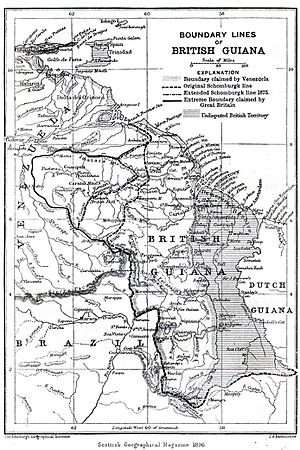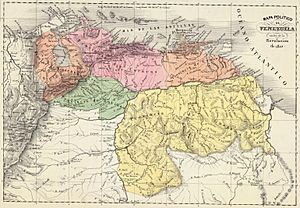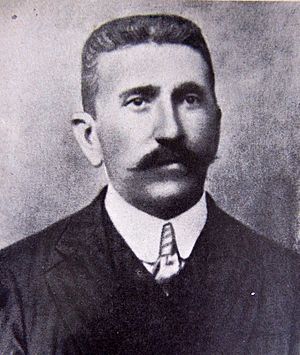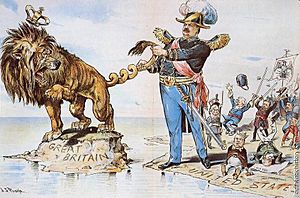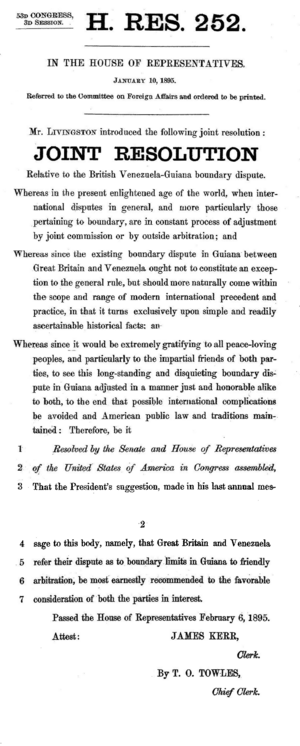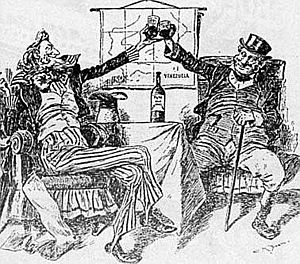Venezuelan crisis of 1895 facts for kids
The Venezuelan crisis of 1895 was a big disagreement between Venezuela and the United Kingdom of Great Britain and Ireland. They were arguing over a large area of land called Guayana Esequiba. Britain said this land was part of its colony, British Guiana. But Venezuela believed it was their territory.
The main problem was that Britain refused to let an international group decide on all the disputed land. They especially didn't want to include the land east of the "Schomburgk Line". This line was drawn by a surveyor many years before. It was meant to show the boundary between Venezuela and the former Dutch land that Britain had taken over.
Eventually, Britain agreed to let the United States help settle the argument. This meant Britain accepted the US's right to step in, based on something called the Monroe Doctrine. A special court met in Paris in 1898 to decide. In 1899, they gave most of the disputed land to British Guiana.
The argument became a serious problem in 1895. A person working for Venezuela, William Lindsay Scruggs, said Britain's actions went against the Monroe Doctrine. This was a US policy from 1823 that warned European countries not to create new colonies in the Americas. US President Grover Cleveland agreed with this idea. He said the US had an interest in anything happening in the Western Hemisphere.
The British Prime Minister, Lord Salisbury, and the British ambassador, Julian Pauncefote, didn't realize how important this was to the US. This made the crisis last longer. But in the end, Britain accepted the US demand for a decision on all the land.
By supporting Venezuela against European powers, President Cleveland made relations better with countries in South America. The friendly way the talks happened also helped relations with Britain. However, by giving in to the US, Britain quietly accepted the Monroe Doctrine. This crisis then set the stage for the US to get more involved in other issues in the Americas. A famous British historian, Robert Arthur Humphreys, later called it a very important event in the history of US-British relations.
Contents
What Caused the Dispute?
By 1895, the argument between Britain and Venezuela over the Guayana Esequiba territory had been going on for 50 years. Britain claimed it as part of British Guiana, while Venezuela said it was theirs. The land claims started long ago. Spain had claimed the area, and Venezuela took over those claims after it became independent in 1830. The Netherlands had also claimed parts of the area. The United Kingdom took over these Dutch claims in 1814 when it got the territories of Essequibo, Demerara, and Berbice.
For centuries, no agreement was reached. By 1895, things got very tense. Diplomatic relations between Britain and Venezuela had been cut off for seven years.
The British based their claim on a survey done in the mid-1800s. A German scientist named Robert Schomburgk explored the area from 1835 to 1839. He drew a map showing what he thought was the western border claimed by the Dutch. The British government then asked him to survey the boundaries of Guiana. This led to the "Schomburgk Line". He drew this line partly following natural features. He also tried to separate land that Spain or Venezuela had settled from land the Dutch had settled. This line went far beyond where the British were actually living. It gave British Guiana control of the mouth of the Orinoco River.
In 1844, Venezuela said the Essequibo River should be the border. Britain offered to change the line and give up the mouth of the Orinoco, but Venezuela ignored it. No treaty was made. In 1850, they agreed not to move into the disputed land. The issue mostly stayed quiet until 1876, when talks started again. Schomburgk's first map was published in 1840. No other version of his line was published until 1886. This made US President Grover Cleveland accuse Britain of secretly extending the line.
In October 1886, Britain said the Schomburgk Line was the temporary border. In February 1887, Venezuela broke off diplomatic relations. Attempts to restart talks failed many times. By 1894, relations had been cut for seven years. Both sides had set up police or military posts in the area. They wanted to protect their claims to the Caratal goldfield. This goldfield was in Venezuela but claimed by the British. The mine at El Callao, started in 1871, was once one of the richest in the world. Many people from Britain and the British West Indies worked in the gold mines. This made it seem like a British colony was forming on Venezuelan land.
Early History of the Region
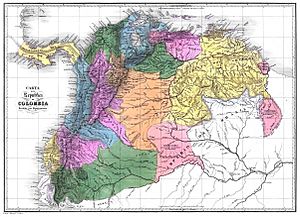
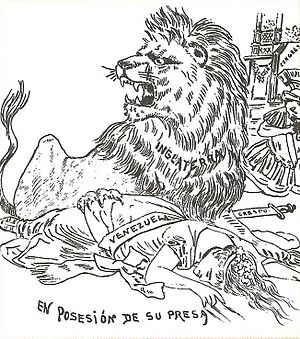
The first people to live in the Tumeremo area were the Guayan and Kamaracoto Indians. They lived by hunting, fishing, and farming. Tumeremo was founded on January 26, 1788. It was called "Mission of Our Lady of Bethlehem of Tumeremo." Capuchin monks from Catalonia founded it. Tumeremo means "Painted Snake" in the language of the first Indians there. The monks started farms for livestock and cotton.
In 1781, British privateers captured Essequibo and Demerara from the Dutch, but they didn't stay long. In 1782, the French took over the colony. But in 1783, the Peace of Paris treaty gave these lands back to the Dutch.
In 1796, the British took permanent control. By 1800, Essequibo and Demerara had about 380 sugarcane farms. At the Peace of Amiens in 1802, the Netherlands got the Essequibo colony back briefly. But after that, the British took it again during the Napoleonic Wars. In 1812, the British renamed Stabroek to Georgetown. Essequibo officially became British territory on August 13, 1814, as part of the Treaty of London. It was combined with the Demerara colony.
This new colony had the Essequibo River as its western border with the Spanish Captaincy General of Venezuela. Spain still claimed the region, but they didn't argue about the treaty. They were busy with their own colonies fighting for independence.
In 1817, General Manuel Piar fought against the Spanish royalists to take control of Spanish Guyana. After freeing Tumeremo, the Spanish survivors were captured. From then on, Tumeremo was an important military base for the patriot soldiers led by Simón Bolívar.
On July 21, 1831, Demerara-Essequibo was joined with Berbice to create British Guiana. The Essequibo River was its western border. However, many British settlers lived west of the Essequibo.
In 1894, some British settlers from British Guyana tried to settle near Tumeremo. This area is now Sifontes Municipality. General Domingo Antonio Sifontes claimed the area on March 2, 1894, near El Dorado. Venezuela set up a military post there. After removing the settlers, Sifontes became a local hero for defending Venezuela's land.
Venezuela had asked the US many times to get involved, referring to the Monroe Doctrine. But the US government had refused. This changed after Venezuela hired William Lindsay Scruggs. Scruggs was a former US ambassador. In 1893, Venezuela hired him to work for them in Washington D.C. as a lobbyist. In October 1894, Scruggs published a pamphlet called British Aggressions in Venezuela: or the Monroe Doctrine on Trial. In it, he attacked Britain's actions. He said Venezuela wanted to settle the border dispute through arbitration. Scruggs also claimed that Britain's policies in the disputed land went against the Monroe Doctrine of 1823. For most of the 1800s, the US rarely used this doctrine. But by the late 1800s, the US started to support its growing business interests in Central and South America more actively. This "new diplomacy" pushed the US more into international struggles. Scruggs used the Monroe Doctrine to help Venezuela.
The Crisis Begins
Scruggs worked with Representative Leonidas Livingston from Georgia. They suggested House of Representatives Resolution 252 to the US Congress. This bill recommended that Venezuela and the United Kingdom settle their dispute by arbitration. President Grover Cleveland signed it on February 22, 1895, after both houses of Congress approved it. The vote was unanimous.
On April 27, 1895, the Royal Navy occupied the Nicaraguan port of Corinto. This happened after some British people were captured there. The British demanded £15,000 as payment. US Secretary of State Walter Q. Gresham thought the demands were harsh but should be met. However, the American public was angry about British military actions so close to the US.
In July 1895, the new Secretary of State, Richard Olney, sent a long document to London. It became known as "Olney's twenty-inch gun." This note reviewed the history of the dispute and the Monroe Doctrine. It strongly insisted that the Doctrine applied to this case. It stated that "today the United States is practically sovereign on this continent." It also said that the US's word was law on matters where it chose to get involved. The President, the Secretary of State, and the US public believed Britain was wrong. They also thought that US interests were at stake and that the US had to step in.
The British government was not much affected by this note. This was partly because Joseph Chamberlain, who worked for the colonies, thought the colony might have a lot of gold near the Schomburgk line. Also, the British disagreed that the Monroe Doctrine had anything to do with the border dispute. A reply to Olney's note directly challenged his view of the Monroe Doctrine. It said the US could not claim that its interests were always involved just because countries were in the Western Hemisphere.
On December 17, 1895, President Cleveland spoke to the US Congress. He repeated that the Monroe Doctrine was important to the dispute. He asked Congress to pay for a commission to study the borders. He also said it was the US's duty to "resist by every means in its power" any British attempt to control land that the US believed belonged to Venezuela. This speech sounded like a direct threat of war with the United Kingdom if they didn't agree. But neither the British nor the American governments actually wanted a war.
On December 18, 1895, Congress approved $100,000 for the US Commission on the Boundary Between Venezuela and British Guiana. It officially started on January 1, 1896. A historian, George Lincoln Burr, who helped the commission, said its work helped clarify the facts of the dispute. He wrote that the commission helped both sides focus on facts that could be proven. By the time the arbitration started, the commission's view of the facts was mostly accepted. This made the main issue a matter of law, not just facts.
The Arbitration Process
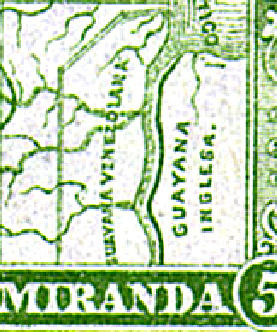
In January 1896, the British government decided to accept the US's right to get involved in the border dispute. They agreed to arbitration without insisting on the Schomburgk line as the starting point for talks. The US and Britain then negotiated the details of the arbitration. Britain managed to convince the US on many points. It also became clear that the Boundary Commission's report would likely not favor the British claims. An agreement between the US and the UK was signed on November 12, 1896. Cleveland's Boundary Commission stopped its work in November 1896, but it still produced a large report.
The agreement set up a special court, called a tribunal. It would have five members. Two members would represent Venezuela, but they would be chosen by the US Supreme Court. Two members would be chosen by the British government. The fifth member, who would lead the group, would be chosen by the other four. Venezuelan President Joaquín Crespo felt this was a "national humiliation." So, the treaty was changed. The Venezuelan President would nominate one tribunal member. But it was understood that his choice would not be a Venezuelan. In fact, he nominated the Chief Justice of the United States. Finally, on February 2, 1897, the Treaty of Washington between Venezuela and the United Kingdom was signed. It was approved a few months later.
After the US and Britain chose their arbitrators, Britain suggested that the two sides agree on the fifth, presiding arbitrator. There were delays in discussing this. In the meantime, Martens was one of the international legal experts suggested by the US. Martens was then chosen by Venezuela from a list of names given by Britain. The Panel of Arbitration included:
- Melville Weston Fuller (Chief Justice of the United States)
- David Josiah Brewer (Member of the US Supreme Court)
- Sir Richard Henn Collins (Lord Justice of Appeal)
- Lord Herschell (former Lord Chancellor), who was replaced by Charles Russell (Lord Chief Justice of England and Wales) after he died.
- Friedrich Martens (a diplomat and legal expert from Russia)
Venezuela's main lawyer was former US President Benjamin Harrison. He was helped by Severo Mallet-Prevost, Benjamin F. Tracy, James R. Soley, and José María Rojas. Britain was represented by its Attorney General, Richard Webster. He was helped by Robert Reid, George Askwith, and Sidney Rowlatt. Sir Frederick Pollock prepared Britain's first argument. The two sides had eight months to prepare their case. They had another four months to reply to the other side's case. And they had three more months for the final written case. The final arguments were given in December 1898. All the evidence and statements filled 23 volumes.
Britain's main argument was that before Venezuela became independent, Spain had not truly controlled the disputed land. They said that the local Native American tribes had made alliances with the Dutch. This gave the Dutch a sphere of influence, which the British then took over in 1814. After 55 days of hearings, the arbitrators took six days to decide. The American arbitrators thought the British argument was ridiculous. They believed Native Americans had never been seen as having sovereignty. However, Britain had an advantage because Martens wanted a unanimous decision. The British threatened to ignore the decision if they didn't like it. They also argued that they would lose unfairly. This was because the treaty said that lands occupied for 50 years would be given to the occupier. Some British gold mines would be lost if their lands were given to Venezuela.
The Outcome
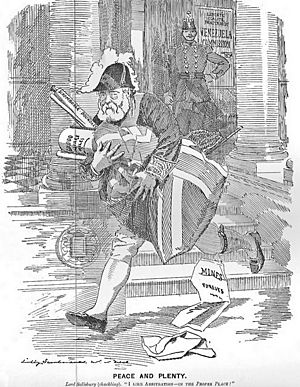
The Tribunal of Arbitration met in Paris and made its final decision on October 3, 1899. The decision was unanimous, but it didn't explain why. It only described the new border. Britain received almost 90% of the disputed territory. The Schomburgk Line was mostly re-established as the border between British Guiana and Venezuela, with a few small changes.
One change was that Venezuela's territory included Barima Point at the mouth of the Orinoco River. This gave Venezuela full control of the river and the ability to charge taxes on trade there. The second change was drawing the border at the Wenamu River instead of the Cuyuni River. This gave Venezuela a good amount of land east of the line that Britain had first refused to include in the arbitration. However, Britain still received most of the disputed land and all the gold mines.
People were surprised by the decision, especially because no reasons were given. Even though Venezuelans were very disappointed, they honored their lawyers for their hard work. Venezuela accepted the decision.
The Anglo-Venezuelan border dispute was the first time the US showed a more active foreign policy, especially in the Americas. It marked the United States as a world power. This was the earliest example of modern interventionism under the Monroe Doctrine. The US used its claimed rights in the Americas.
What Happened Next?
The Olney–Pauncefote Treaty of 1897 was a proposed agreement between the United States and Britain. It would have required them to use arbitration for major disagreements. However, the US Senate rejected the treaty, so it never became law.
The 1895 dispute between the US and Britain over Venezuela was solved peacefully through arbitration. Both nations realized they needed a way to avoid future conflicts. US Secretary of State Richard Olney negotiated an arbitration treaty with the British diplomat Julian Pauncefote in January 1897. President William McKinley supported the treaty, as did many important leaders and newspapers. The main opposition came from Irish-Americans, who had a very negative view of Britain.
In the US Senate, however, several changes were made to the treaty. These changes removed important issues from arbitration. Any issue that was not removed would need two-thirds of the Senate's approval before arbitration could begin. Almost nothing was left of the original proposal. In May 1897, the Senate voted 43 in favor to 26 against. This was three votes short of what was needed to pass. The Senate wanted to keep control over treaties. They also had some deep-rooted anti-British feelings.
Even though Venezuela was disappointed with the decision from the Paris Tribunal of Arbitration, it accepted it. However, 50 years later, a document was published that suggested a secret political deal between Russia and Britain. This led Venezuela to bring up its claims again. In 1949, a US legal expert named Otto Schoenrich gave the Venezuelan government the Memorandum of Severo Mallet-Prevost. Mallet-Prevost was the official secretary for the US/Venezuela team in the arbitration. He wrote the memo in 1944, saying it should only be published after he died.
This memo reopened the issues. Mallet-Prevost guessed there was a political deal between Russia and Britain based on how the judges acted later. He said that Martens had visited England with the two British arbitrators in the summer of 1899. Martens had offered the two American judges a choice. They could either accept a unanimous decision like the one that was finally agreed upon. Or they could have a 3-2 majority decision that would be even more favorable to the British. This alternative would have followed the Schomburgk Line completely and given the mouth of the Orinoco River to the British. Mallet-Prevost said the American judges and Venezuelan lawyers were upset by this. They thought about the 3-2 option with a strong written disagreement. But they finally went along with Martens to avoid Venezuela losing valuable land it deserved.
Because of Mallet-Prevost's claims, Venezuela brought back its claim to the disputed territory in 1962. In 2018, Guyana asked the International Court of Justice to declare that the 1899 decision is still valid and binding for both Guyana and Venezuela. They also want the border set by that decision and the 1905 Agreement to be declared valid.
See also
- The Monroe Doctrine (1896 film) – A US propaganda film.


